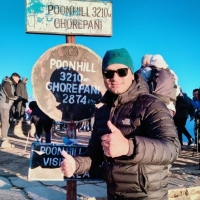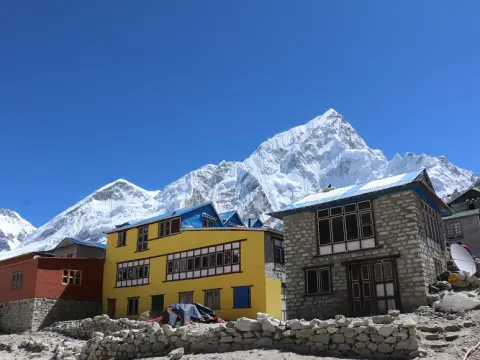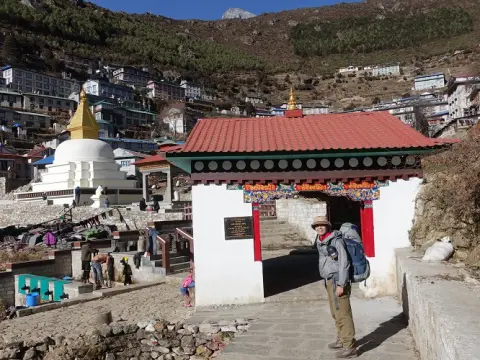Accommodation on Everest Base Camp Trek: Guide
Everest Base Camp Trek: OverviewEverest Base Camp Trek is amongst the most famous hikes in the globe. Actually, it starts from Lukla, standing at 2,86...


In addition, Thukla is also renowned for its quiet, peaceful surroundings, unlike the more crowded villages along the trail such as Namche Bazaar. The calm surroundings allow trekkers to relax and recover after tiring days of hiking. Scattered alpine bushes and rocky outcrops engulf Thukla. The scenery is a sign of the harsh climate and elevation of this Himalayan area.
In a similar way, Thukla is also home to the famous Everest Memorial, or the Khumbu Cemetery. This important site is a memorial to climbers who perished attempting to reach Mount Everest and other summits. Trekkers pause to visit this memorial to pay their respects and ponder the risk of climbing at high altitude. This memorial adds a somber and emotional tone to this small village.
Moreover, the settlement of Thukla is largely composed of a couple of tea houses and lodges. They offer basic shelter and sustenance befitting the high-altitude environment. Electricity is limited and mainly drawn from solar energy. The heat is supplied by traditional wood or yak dung stoves to sustain cold nights.
Additionally, the village Thukla sits at a high elevation that provides a breathtaking view of towering Himalayan peaks such as Nuptse (7,861 meters) and Lhotse (8,516 meters). Looming over the horizon and inviting climbers to continue upward are these breathtaking peaks. Thukla's scenery is breathtaking, making this a significant milestone on the Everest trek.
In conclusion, Thukla is a vital landmark for those trekking to Everest Base Camp. Its elevation, remoteness, and memorial spot give it a unique status. Thukla is the favorite resting ground for most trekkers who employ it to acclimatize and prepare themselves for the journey ahead. The village offers a combination of nature's beauty and cultural significance with logistical facilities for mountain trekkers.
Also, the landscape surrounding Thukla is extremely rough and hilly. Steep rock slopes rise up sharply on either side of the track. The landscape is completely unvegetated due to the high altitude and cold conditions. Only a few hardy alpine flowers flourish at the warmer summer months. They add splashes of green to the rocky landscape.
Equally, Thukla provides a perspective on the valley of the Khumbu Glacier, one of the world's most famous glaciers. The glacier comes down from the west face of Mount Everest. Trekkers on the route close to Thukla get a glimpse of the ice cliffs and moraine plateaus displaying this large glacial system. These remind tourists about the power of geological activity deforming the region.
Also, the Dudh Koshi River is lower in the valley, far below Thukla. It is a river that begins as glacial melt high in the Himalayas. While not visible from Thukla, the far-off sound of water can sometimes be heard along the trail. The river plays a major role in cutting down the lower parts of the Everest trekking trail.
Also, several giant Himalayan peaks surround Thukla. Nuptse, standing at 7,861 meters, lies to the west, while Lhotse, standing at 8,516 meters, rises up to the east. These massive white peaks loom over the horizon and possess stunning panorama sight. Because they are so close, they create a captivating and inspiring scenery for climbers.
In fact, while returning from Everest Base Camp and Kalapattar, people make a transit either to Dingboche or Pangboche via Thukla. Mostly, people transit to Pangboche while returning from EBC and Kalapattar.
In summary, Thukla's geography and location position it as a scenic and significant rest stop on the Everest trek. The village is along a rough road flanked by massive mountains and glaciers. Its geography establishes the grandeur and austerity of the Everest region. Trekkers enjoy Thukla as much for rest as for its exquisite natural beauty.
Moreover, the hike from Pheriche to Thukla would normally take between three and four hours. The route climbs slowly from Pheriche's elevation of 4,280 meters. This slow climb gives climbers a chance to gradually acclimatize to greater elevations. Along the way, climbers get views of distant peaks and rugged terrain that prepare them for what is to come.
Likewise, trekking from Lobuche to Thukla normally takes two hours. The latter is a downward trek since Lobuche stands higher at approximately 4,940 meters. The trek goes through stone slopes and at times crosses small rivers. As shorter, the trekking could be physically demanding because of the irregular terrain and altitude.
Furthermore, flights by helicopter only go up to Lukla or Namche Bazaar, and helicopters never touch down in Thukla. Helicopter access is made impossible by terrain and high elevation under usual conditions. Helicopters from nearby locations may be utilized in case of evacuation in emergencies, but all normal access to Thukla is via walking.
Moreover, trekking season also strongly affects trail conditions and accessibility to Thukla. Spring and autumn are the best seasons, as they have pleasant weather and clear skies. The winter season has snow over the trail and makes it slippery and risky to traverse. The summer monsoon season produces heavy rain and makes trails muddy and prone to sporadic landslides.
Overall, Thukla can only be reached by trekking on hilly and rocky ground. Physical condition and prior planning are required because of its remote location. Weather and season depend on it, making it necessary to plan. Despite all circumstances, the trek to Thukla is worthwhile with stunning vistas and crucial acclimatization.
Furthermore, electricity is limited in Thukla and is offered largely from solar panels. Power outages are common, especially on stormy or overcast days. Traditional yak dung or wood stoves are used for lodge heating. Guests are offered blankets to help them stay warm during chilly mountain nights.
Likewise, tea houses in Thukla also provide healthy food that caters to the needs of trekkers at high altitudes. Dal bhat, noodles, soups, and tea are the staple food. Herbal tea and coffee are provided hot throughout the day. Some of the dining rooms provide panoramic views of surrounding peaks, enhancing the dining experience.
Additionally, there are hardly any medical facilities at Thukla. There is no clinic or hospital within the village. Some of the lodges have basic first aid kits, but these are not substitutes for proper medical care. In the case of serious illness or injury, evacuation to Namche Bazaar or Kathmandu is necessary, at times by helicopter.
Also, Wi- Fi and internet connectivity is available in Thukla but limited . Such limited communication preserves the serenity of the village but is a hindrance for those who need entry to the outside world. Trekkers need to plan ahead, probably with satellite phones as a precaution against emergencies.
In fact, Thukla is a lunch stop or tea stop between Dingboche and Pangboche and Lobuche while doing Everest Base Camp Trek.
Lastly, Thukla provides simple but essential amenities needed for high-altitude trekking. In small numbers, however, the services are adequate to cater to the general needs of trekkers climbing the Everest trail. The physical isolation and elevation of the village effectively restrict advanced amenities. Visitors depend on Thukla for shelter, food, and relaxation between their challenging climb.
Further, Thukla also offers stunning views of high Himalayan mountains. Nuptse (7,861m) lies to the west, and Lhotse (8,516m) lies to the east. Ama Dablam (6,812m), a most beautiful peak, is in the distance. These massive mountains make for an incredible backdrop for visitors.
Moreover, equally appealing to nature lovers and trekkers in Thukla are the surrounding rough topography. Rocky slopes, alpine shrubland thinning out, and glaciers characterize the area. The rough high-altitude terrain reflects the extreme conditions of the Everest region. Trekkers like this unique mountain terrain.
In addition, the cultural aspects of the Thukla village contribute to its appeal. Prayer flags wave in the wind, and humble Sherpa tea houses bear quaint Buddhist symbols. Tourists frequently receive genuine Sherpa hospitality and cultural practices here. Exposure to culture enhances the trekking experience.
Also, short acclimatization treks near Thukla are preferred before heading to Lobuche and Everest Base Camp. Trekkers go to adjacent ridges and viewpoint areas to acclimatize at altitude. These treks exhibit panoramic mountain views and glacier landscapes. They also improve physical conditioning for increased altitudes.
In total, Thukla attractions combine nature beauty, cultural diversity, and memorial appeal. The Everest Memorial and magnificent peaks are what distinguish it. Trekkers become inspired and moved by Thukla.
Besides, Thukla has a unique peaceful environment that attracts most trekkers. It is unlike congested villages where one finds busy activity all around. It is serene and quiet. This serenity allows the hikers to restore energy and focus. The natural environment complements the relaxing process.
Similarly, the Thukla village's location near breathtaking Himalayan mountains draws tourists. Nuptse (7,861 m), Lhotse (8,516 m), and Ama Dablam (6,812 m) encircle the region. These magnificent peaks motivate and inspire trekkers. Photographers particularly relish the stunning outlook.
Besides that, the Everest Memorial is emotionally rewarding in thukla. Some trekkers visit here in order to pay homage to those who have died on the mountain. This sacred site inspires respect and regard for mountaineering risks. It also highlights Everest's harsh conditions.
Besides that, simple tea houses and lodges provide warm meals and lodging here in Thukla. Trekkers unwind after long day-long hikes. The combination of nature, culture, and ease makes Thukla popular.
Lastly, Thukla is popular because of its ideal altitude, peace, mountain view, and memorial. It is still a major and significant point on the Everest trail.
Accommodation and Tea Houses
Thukla provides simple but basic shelter for trekkers. There are a few tea houses and lodges with simple rooms equipped with basic amenities. The majority of rooms have common bathrooms, and some also include hot shower facilities. Wood or yak dung stoves provide the heating needed on cold days.
Furthermore, healthy meals for high-altitude requirements are provided in the tea houses located in Thukla. Dal bhat, noodles, soup, and tea are usual foods. Warm drinks keep trekkers warm and alert. The most of the dining rooms provide breathtaking views of mountains, thereby making meals more enjoyable.
Likewise, prices of lodges and foods in Thukla increase for peak trekking seasons such as spring and autumn. Groups or peak seasons should be booked in advance. These tea houses accept cash only, and thus trekkers need to carry enough Nepali rupees.
Moreover, the tea houses in Thukla are owned by families and are run as part of Sherpa communities. Guests are treated with polite hospitality and exposed to native culture. The personal touch adds warmth to the stay.
Further, certain lodges in Thukla offer simple amenities like phone charging and laundry facilities. These typically have extra charges attached to them. Mobile networks and internet accessibility are poor or nonexistent, a reflection of how remote the village is. One should expect minimal connectivity.
In short, Thukla's tea houses and guest houses offer trekkers the minimum essentials. They offer warmth, filling food, and resting spots in a remote environment. The scenic views and friendly atmosphere make Thukla a popular stopover on the Everest Base Camp trek.


Everest Base Camp Trek: OverviewEverest Base Camp Trek is amongst the most famous hikes in the globe. Actually, it starts from Lukla, standing at 2,86...

Introduction Namche Bazaar is a lively town in the Everest region. It is situated at 3,440 meters above sea level. The village is the main tradin...

IntroductionTo begin with, Tengboche is a village standing at 3,867 meters above sea level in Nepal. It is famous for the Tengboche Monastery, one of...
